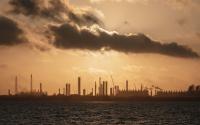26 January 2006BBC News
It is perhaps too early to talk of an energy "crisis".
 Fossil fuels have been the cheapest and most convenient so far |
But take your pick from terms like "serious concern" and "major issue" and you will not be far from the positions which analysts are increasingly adopting.
The reason for their concern can be found in a set of factors which are pulling in glaringly different directions: Demand for energy, in all its forms, is rising Supplies of key fuels - notably oil and gas - show signs of decline Mainstream climate science suggests that reducing greenhouse gas emissions within two decades would be a prudent thing to do Meanwhile the Earth's population continues to rise, with the majority of its six billion people hankering after a richer lifestyle - which means a greater consumption of energy.
Underlying the growing concern is the relentless pursuit of economic growth, which historically has been tied to energy consumption as closely as a horse is tethered to its cart.
It is a vehicle which cannot continue to speed up indefinitely; it must at some point hit a barrier, of finite supply, unfeasibly high prices or abrupt climate change.
The immediate question is whether the crash comes soon, or whether humanity has time to plan a comfortable way out.
Even if it can, the planning is not necessarily going to be easy, or result in cheap solutions. Every energy source has its downside; there is no free lunch, wherever you look on the menu.
Runaway horse
The International Energy Agency (IEA) predicts a rise in global energy demand of 50-60% by 2030.
If all else remained equal, that rising demand would be accommodated principally by fossil fuels, which have generally been the cheapest and most convenient available.
 |
But oil supplies show signs of running down; this, combined with concerns about rising demand and political instability, conspired to force prices up from $40 a barrel at the beginning of 2005 to $60 at its close.
There is more oil out there, for sure; but the size of proven reserves is uncertain, with oil-producing countries and companies prone to exaggerate the size of their stocks. Currently uneconomic sources such as tar sands could be exploited; but at what cost?
Natural gas stocks - in recent times the fuel of choice for electricity generation are also showing signs of depletion, and there is growing concern in Western capitals about the political instability associated with oil and gas supplies from the Middle East and Russia.
Coal, the fuel of the industrial revolution, remains relatively abundant; but here the climate issue raises its provocative head most volubly, because of all fuels, coal produces more greenhouse gas emissions for the energy it gives.
Based partly on the predicted availability of cheap coal, the IEA forecasts a 50% rise in greenhouse gas emissions by 2030.
Mainstream climate science, meanwhile, indicates that to avoid dangerous consequences of climate change, emissions should fall, not rise, by 50%.
The economic and environmental horses are clearly pulling in mutually incompatible directions.
No climate curbs
It is a rare human that dons a hair shirt voluntarily; and in seeking to deal with climate change, we are, it seems, behaving to type.
It took the world's most comfortably-off nations more than seven years to bring the Kyoto Protocol into force following its signing in 1997.
 Sharp divisions over nuclear power show no signs of disappearing |
An alternative "climate pact", the Asia-Pacific Partnership on Clean Development and Climate, emerged last year contending that technology alone would solve global warming.
It recently concluded its first ministerial meeting by endorsing projections that under its aegis, emissions will at least double by 2050; economic growth is sacrosanct, and so consumption of coal and other fossil fuels must also continue to rise.
Concern over climate change, then, is not on a global basis proving to be a driver for clean technology or for reducing demand for energy.
Price barriers
Rising prices or simply constraints on supplies of fossil fuels could, however, bring other fuels into the equation; and nuclear fission is at the head of the queue.
According to the World Nuclear Association, there are now about 440 commercial reactors in the world, providing 16% of its electricity; for major developing countries such as India and China, nuclear power remains both a significant part of the electricity mix and a close companion to military programmes.
But concerns over waste have set other countries such as Germany on a determinedly non-nuclear path.
Waste apart, nuclear faces another potential obstacle; stocks of uranium are finite.
 Photo-voltaic cells: The look of the future? |
Analysts differ over how soon a uranium deficit might emerge; some believe that a significant ramping up of nuclear capacity would exhaust economic reserves on a timescale of decades.
That could be extended by adopting "fast breeder" reactors, which create more fissile material as they go.
Too good to be true? Perhaps, because there is a major downside; the creation of plutonium, with its attendant dangers of proliferation.
The other nuclear technology, fusion, is full of hope but even its most ardent supporters admit it is decades away.
Wind, waves and sunlight
Most of the energy we use on Earth comes directly or indirectly from the Sun.
It is the Sun which stirs winds and the great water cycle, depositing rain on highlands and creating the potential for hydro-electric power; it is the Sun's energy which grew plants which decayed to form the coal and oil that we have extracted so determinedly in our industrial age.
Is it now time, then, to use its energy directly, to blanket the Earth in photo-voltaic cells and silently power humankind's future?
Certainly it could be done, with energy to spare; but at costs up to five times that of coal and gas, it is not going to be soon.
Wind, wave and tidal power are all fine technologies, but their potential is limited, not least by the fact that they do not generate continuously.
That could be overcome by storing energy. But there are few realistic ways of doing it; and the additional cost would quickly negate any advantage these technologies currently possess.
Hydrogen, meanwhile, is touted as the great climate-friendly hope.
But hydrogen is just a carrier of energy. It must be created, for example by using electricity to split water molecules, in which case replacing petrol-driven cars with hydrogen vehicles would vastly increase the global demand for electricity.
No free lunch, indeed - but a desperately tortuous and risk-laden menu and a kitchen where political or environmental fires could flare up at any moment.






